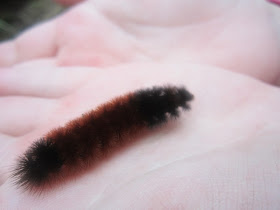Although we're not that fascinated with moths, we are noticing quite a few woolly bear caterpillars in the east pasture which the girls enjoy seeing. They seem to either be rolled into balls, basking in the sun, or quickly crawling to a new location.
In the book Handbook of Nature Study by Ann a Botsford Comstock, there were some interesting facts about Woolly Bear and Isabella Tiger Moths:
----->> If "woolly bear" caterpillars are already curled up for winter, they will "come to" if warmed in the hand or in the sunshine.
Woolly bear caterpillar in Sophia's hand.
----->> There are actually 13 segments to the caterpillar, but the last two appear joined so it looks like there are 12 segments (not including the head).
Some of the segments and rosettes of hair
on a woolly bear caterpillar.
----->> The yellow spot on either side of the first segment is a spiracle. It's the opening leading int othe air tubes within the body, around which the blood flowers and is thus purified.
The yellow spots were visible when we were looking at them.
They aren't quite so obvious in the picture,
but they are on the right side of the picture/caterpillar.
----->> The eyes are too small to be seen. Because the eyes are so small, the woolly bear can't see very far so it stretches its body from side to side so it can see if there's anything it can cling to as it moves.
----->> When we try to hold the woolly bear, it rolls up in a little ball. The hairs are a protection from the attacks of birds which do not like bristles for food.
Sophia and Olivia holding caterpillars
that are rolled into balls.
Much of the east pasture/nature trail is goldenrod, grass,
clover, and these white daisy-type flowers
(a plant that has seemed to increase substantially
from last year to this year).
----->> The cocoon is made in April and May, and appears to be made of felt. The moth emerges in late May and is quite large compared to the caterpillar that went into it.
----->> The moths are night fliers.
The girls were interested in seeing how long the caterpillar were. Most seemed to be about one inch long.
Measuring a caterpillar.
They were all about an inch long.
This year there have been an abundance of the woolly bears in the east pasture/nature trail area. We noticed there were none in the west pasture. Not sure why there would be so many compared in one area compared to another. Nonetheless, it will be interesting to see if there are more of the moths in the late-spring and early-summer in 2012.







I have seen these a couple of times in our area and they are so adorable! I love the images you captures with the segments showing and then all curled up.
ReplyDeleteGreat facts and a great study. Thank you so much for sharing your study with the OHC.
I remember playing with woolly bear caterpillars as a little girl.
ReplyDelete